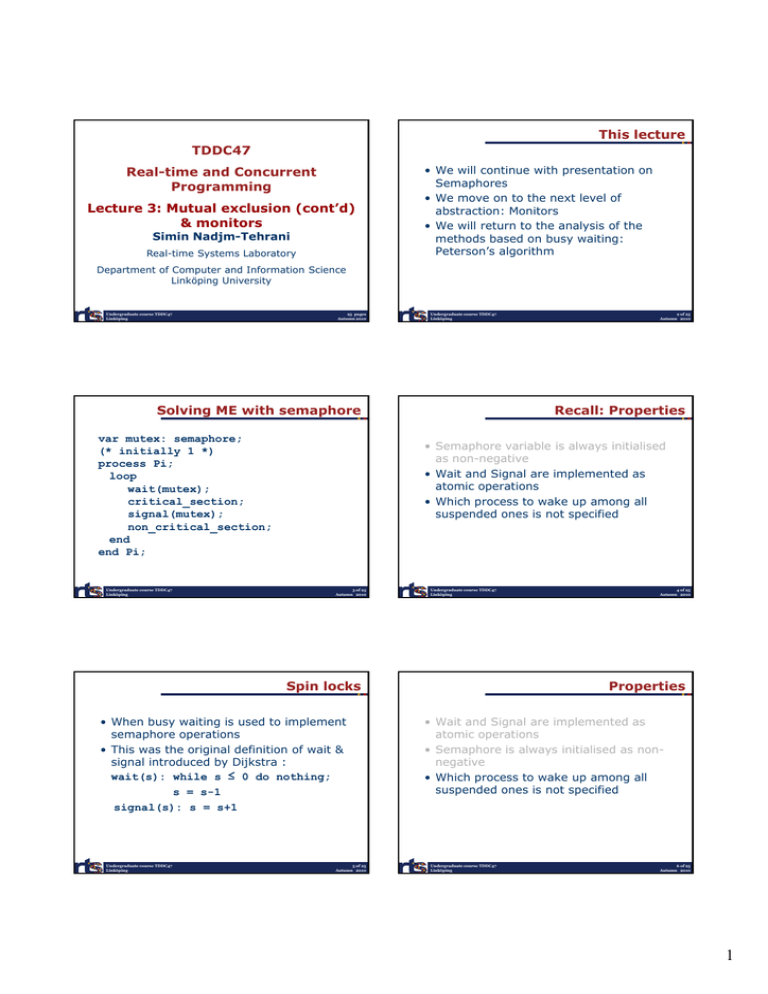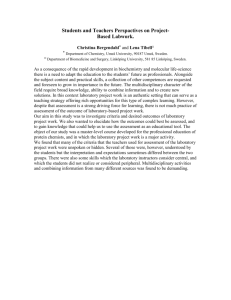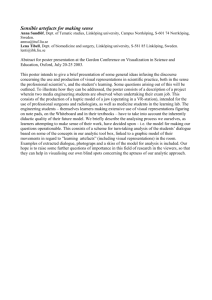This lecture TDDC47 Real-time and Concurrent Programming
advertisement

This lecture TDDC47 Real-time and Concurrent Programming Lecture 3: Mutual exclusion (cont’d) & monitors Simin Nadjm-Tehrani Real-time Systems Laboratory • We will continue with presentation on Semaphores • We move on to the next level of abstraction: Monitors • We will return to the analysis of the methods based on busy waiting: Peterson’s algorithm Department of Computer and Information Science Linköping University Undergraduate course TDDC47 Linköping 25 pages Autumn 2010 Undergraduate course TDDC47 Linköping Solving ME with semaphore var mutex: semaphore; (* initially 1 *) process Pi; loop wait(mutex); critical_section; signal(mutex); non_critical_section; end end Pi; Undergraduate course TDDC47 Linköping Recall: Properties • Semaphore variable is always initialised as non-negative • Wait and Signal are implemented as atomic operations • Which process to wake up among all suspended ones is not specified 3 of 25 Autumn 2010 Undergraduate course TDDC47 Linköping Spin locks • When busy waiting is used to implement semaphore operations • This was the original definition of wait & signal introduced by Dijkstra : wait(s): while s ≤ 0 do nothing; s = s-1 signal(s): s = s+1 Undergraduate course TDDC47 Linköping 2 of 25 Autumn 2010 5 of 25 Autumn 2010 4 of 25 Autumn 2010 Properties • Wait and Signal are implemented as atomic operations • Semaphore is always initialised as nonnegative • Which process to wake up among all suspended ones is not specified Undergraduate course TDDC47 Linköping 6 of 25 Autumn 2010 1 How to implement? process P1; process P2; process P3; … … … wait(s) wait(s) wait(s) … … … signal(s) signal(s) signal(s) … … … end; end; end; Semaphores vs. Busy waiting • For long critical sections, semaphores more efficient in using CPU • Better code organisation, less errors? • What about reasoning about correctness, issues with deadlock and starvation? • We will come back to these… Queue of suspended processes: Undergraduate course TDDC47 Linköping 7 of 25 Autumn 2010 Undergraduate course TDDC47 Linköping This lecture 8 of 25 Autumn 2010 What is a monitor? • A programming abstraction consisting of: – Data structure on which programmer can define operations – to be run one at a time – Condition variables for synchronisation • We will continue with presentation on Semaphores • We move on to the next level of abstraction: Monitors • We will return to the analysis of the methods based on busy waiting: Peterson’s algorithm • Encapsulates shared data that several processes can operate upon • In addition: automatic mutual exclusion • Pre object-orientation! [Hoare 74] Undergraduate course TDDC47 Linköping 9 of 25 Autumn 2010 Undergraduate course TDDC47 Linköping 10 of 25 Autumn 2010 Condition variables Overview • Declared as special synchronisation variables: Condition X; Shared data Condition variables X, Y • With two designated operations: Wait(X): suspend the calling process Operations on Shared data Signal(X): if there are suspended processes on this variable, wake one up Initialisation code Undergraduate course TDDC47 Linköping 11 of 25 Autumn 2010 Undergraduate course TDDC47 Linköping 12 of 25 Autumn 2010 2 Properties • wait and signal can be called within any of the operations Process queues Queue of processes wanting to execute some monitor Note: • The condition variable has no values assigned to it • The queue associated with it is the main synchronisation mechanism • Different semantics from semaphore operations for wait and signal Shared data Condition variables X, Y operation X: queue for processes waiting for X queue for f processes waiting for Y Y: Operations on Use wait/signal operations on condition Shared data Initialisation code variables Undergraduate course TDDC47 Linköping 13 of 25 Autumn 2010 Undergraduate course TDDC47 Linköping 14 of 25 Autumn 2010 Options How does it work? • Original Hoare monitor: let the woken up process (P1) continue Process P1 … wait(X) Process P4 … What if there are several processes waiting on X? P Process P2 signal(X) … t • Pragmatic solution (Java): let the signalling process continue, and wake up P1 once P4 is suspended/exits Which process to run at time t? P1 has to check for condition X when woken up! time Undergraduate course TDDC47 Linköping 15 of 25 Autumn 2010 Undergraduate course TDDC47 Linköping Example: Bounded buffer 16 of 25 Autumn 2010 Operation Append (* in some language that supports monitors *) operation Append (E: integer); begin if Count == SizeOfBuffer + 1 then wait(NotFull); Buff[Top] = E; Top = (Top + 1) mod SizeOfBuffer; Count = Count + 1; signal(NotEmpty) end Append; monitor BoundedBuffer; Buf: array [0..SizeOfBuffer] of integer; Base, Top: integer; Count: integer; NotFull, NotEmpty: condition; operation ti A Append(E: d(E integer); i t ) ... end Append; operation Take(var E: integer); ... end Take; begin <initialize> (* set Base,Top,Count to 0 *) end BoundedBuffer; Undergraduate course TDDC47 Linköping 17 of 25 Autumn 2010 Undergraduate course TDDC47 Linköping 18 of 25 Autumn 2010 3 Operation Take operation Take (var E: integer); begin if Count == 0 then wait(NotEmpty); E = Buff[Base]; Base = (Base + 1) mod SizeOfBuffer; Count = Count - 1; signal(NotFull) end Take; Undergraduate course TDDC47 Linköping 19 of 25 Autumn 2010 Producer-Consumer problem process Producer; var Current: integer; begin loop Produce(Current); Append(Current) end end Producer; Undergraduate course TDDC47 Linköping Summary • Monitors have the same power as semaphores but are at a higher level of abstraction – Exercise: Try implementing producerconsumer solution with semaphores! • Monitor has different mechanisms for handling synchronisation and for data communication • Mutually exclusive access to data automatic, but matching waits and signals still a problem! Undergraduate course TDDC47 Linköping 21 of 25 Autumn 2010 20 of 25 Autumn 2010 This lecture • We will continue with presentation on Semaphores • We move on to the next level of abstraction: Monitors • We will return to the analysis of the methods based on busy waiting: Peterson’s algorithm Undergraduate course TDDC47 Linköping Peterson’s algorithm process P1 loop flag1 = up turn = 2 while flag2 == up and turn == 2 do nothing end critical-section flag1 = down non-critical-section end process Consumer; var Current: integer; begin loop Take(Current); Consume(Current) end end Consumer; 22 of 25 Autumn 2010 Recall: last lecture • How does one argue about correctness of Peterson’s algorithm? • Will show that – Processes respect mutual exclusion – A process will not be waiting to enter its critical section indefinitely How do we show that it actually works? Undergraduate course TDDC47 Linköping 23 of 25 Autumn 2010 Undergraduate course TDDC47 Linköping 24 of 25 Autumn 2010 4 Questions? Undergraduate course TDDC47 Linköping 25 of 25 Autumn 2010 5



